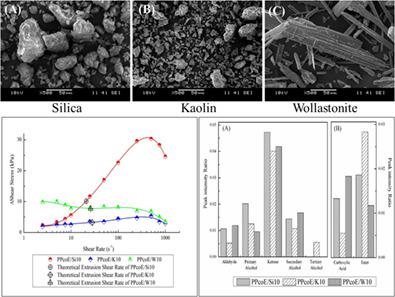当前位置:
X-MOL 学术
›
Polym. Compos.
›
论文详情
Our official English website, www.x-mol.net, welcomes your
feedback! (Note: you will need to create a separate account there.)
The thermal‐mechanical degradation of mineral‐filled polypropylene‐ethylene copolymer composites during extrusion process
Polymer Composites ( IF 4.8 ) Pub Date : 2020-09-17 , DOI: 10.1002/pc.25809 Lip Teng Saw 1 , Firuz Zainuddin 1 , Xuan Viet Cao 2 , Du Ngoc Uy Lan 3
Polymer Composites ( IF 4.8 ) Pub Date : 2020-09-17 , DOI: 10.1002/pc.25809 Lip Teng Saw 1 , Firuz Zainuddin 1 , Xuan Viet Cao 2 , Du Ngoc Uy Lan 3
Affiliation

|
This work proposes a new understanding of the side effect of mineral fillers in polymer compounding that caused different levels of thermo‐mechanical degradation (TMD) during extrusion. Three mineral fillers, silica (random shape), kaolin (platy), and wollastonite (needle‐like), were selected and compounded with the polypropylene‐ethylene copolymer (PPcoE) using a twin‐screw extruder. Their influences on the TMD of PPcoE were examined by checking the substances in the extrudates using Fourier transform infrared spectroscopy. The built‐up shear stress causing by mineral filler in PPcoE composite (Δτcom) as the root of TMD was measured and estimated using capillary rheometer. In this study, TMD is classified as two levels: chain scission and oxidization. These fillers were found to accelerate the TMD mechanism and generate the oxidised products during extrusion. The silica filler caused the highest Δτcom, the lowest tensile strength, and elongation at break of PPcoE composites. The kaolin filler gave the most potent accelerating effect on oxidization, resulted in the formation of tertiary alcohol, and the highest ester contents in PPcoE composites; although, its composite had the lowest Δτcom among the fillers. Lastly, wollastonite filler provided higher Δτcom than kaolin composite, the second‐highest formation of alkene products, yet better retention in elongation at break compared to the silica‐filled PPcoE composite. In general, the side effect of mineral filler on TMD was a larger particle size always comes with higher chain scission, simpler particle morphology gives a smoother built‐up shear stress and minimizes TMD, and filler having hydroxyl groups catalyzes the oxidization TMD.
中文翻译:

矿物填充聚丙烯-乙烯共聚物复合材料在挤出过程中的热机械降解
这项工作提出了一种新的认识,即矿物填料在聚合物配混中的副作用,该副作用会在挤出过程中引起不同程度的热机械降解(TMD)。选择了三种矿物填料,二氧化硅(无规形状),高岭土(板状)和硅灰石(针状),并使用双螺杆挤出机与聚丙烯-乙烯共聚物(PPcoE)混合。通过使用傅立叶变换红外光谱法检查挤出物中的物质,检查了它们对PPcoE TMD的影响。积聚的剪切应力通过无机填料在PPcoE复合引起(Δτ COM使用毛细管流变仪测量并估算TMD的根)。在这项研究中,TMD分为两个级别:断链和氧化。发现这些填料可加速TMD机理并在挤出过程中产生氧化产物。二氧化硅填料引起最高Δτ COM,最低拉伸强度,和断裂伸长率PPcoE复合材料的断裂。高岭土填料对氧化作用最强,促进了叔醇的形成,PPcoE复合材料中的酯含量最高。虽然,它的复合材料具有最低Δτ COM填料中。最后,硅灰石填料提供更高Δτ COM与高岭土复合材料相比,烯烃产物的形成量第二高,但与二氧化硅填充的PPcoE复合材料相比,其断裂伸长率保留率更高。通常,矿物填料对TMD的副作用是较大的粒径始终伴随着较高的断链,更简单的颗粒形态可提供更平滑的积聚剪切应力,并使TMD最小化,而具有羟基的填料则催化氧化TMD。
更新日期:2020-09-17
中文翻译:

矿物填充聚丙烯-乙烯共聚物复合材料在挤出过程中的热机械降解
这项工作提出了一种新的认识,即矿物填料在聚合物配混中的副作用,该副作用会在挤出过程中引起不同程度的热机械降解(TMD)。选择了三种矿物填料,二氧化硅(无规形状),高岭土(板状)和硅灰石(针状),并使用双螺杆挤出机与聚丙烯-乙烯共聚物(PPcoE)混合。通过使用傅立叶变换红外光谱法检查挤出物中的物质,检查了它们对PPcoE TMD的影响。积聚的剪切应力通过无机填料在PPcoE复合引起(Δτ COM使用毛细管流变仪测量并估算TMD的根)。在这项研究中,TMD分为两个级别:断链和氧化。发现这些填料可加速TMD机理并在挤出过程中产生氧化产物。二氧化硅填料引起最高Δτ COM,最低拉伸强度,和断裂伸长率PPcoE复合材料的断裂。高岭土填料对氧化作用最强,促进了叔醇的形成,PPcoE复合材料中的酯含量最高。虽然,它的复合材料具有最低Δτ COM填料中。最后,硅灰石填料提供更高Δτ COM与高岭土复合材料相比,烯烃产物的形成量第二高,但与二氧化硅填充的PPcoE复合材料相比,其断裂伸长率保留率更高。通常,矿物填料对TMD的副作用是较大的粒径始终伴随着较高的断链,更简单的颗粒形态可提供更平滑的积聚剪切应力,并使TMD最小化,而具有羟基的填料则催化氧化TMD。











































 京公网安备 11010802027423号
京公网安备 11010802027423号